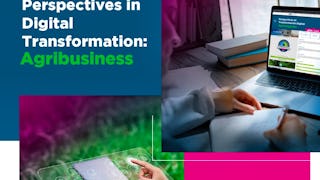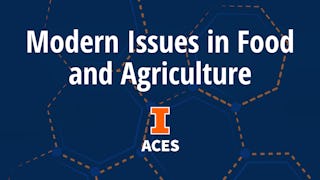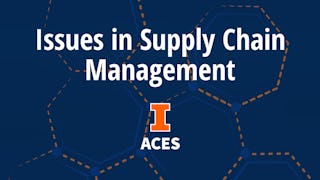The goal of this course is to understand the challenges and opportunities of agribusiness nowadays. From farms to retailers, from input providers to traders, all the diverse players of this value chain interact a complex business environment in which nature, policy, technology and management strategies have to be considered to overcome future challenges and seize upcoming opportunities.

Enjoy unlimited growth with a year of Coursera Plus for $199 (regularly $399). Save now.

Challenges of Agribusiness Management

Instructor: Vitaliano Fiorillo
18,637 already enrolled
Included with
(278 reviews)
Skills you'll gain
Details to know

Add to your LinkedIn profile
5 assignments
See how employees at top companies are mastering in-demand skills

There are 5 modules in this course
The week focuses its attention on the challenges of the global agro-system. Population growth, income growth, transition of emergent economies toward a high-calorie diet: all these levers increase the demand for food. At the same time, climate change and its consequences threaten the production of sufficient food to feed the world. Another theme investigated during the first week is the process of commoditization that characterizes agricultural products. Firstly, distinctive aspects of commodities are analysed. At a later stage, the impact of industrialization and economy of services on price transmission along the agro-food value chain is discussed.
What's included
10 videos1 reading1 assignment
The second week gives an overview of actual agribusiness competitive dynamics focusing on the role and features of each player of the supply chain. Then, the five largest agricultural systems in the world are examined (Europe, US, Brazil, China and India). Each agricultural system is explained going through its history, evolution and main features in terms of typical productions, commercial relations, trends and dynamics that will affect it in the years to come. The final part of the week deepens the Italian agricultural system. The conditions, skills and competences that have allowed Italy to become the first country in the world in terms of quality agri-food products are discussed and summarized.
What's included
13 videos1 reading1 assignment
The third week is about sustainability in agriculture. Sustainable agriculture contributes to all four pillars of food security (availability, access, utilization and stability) and to the three dimensions of sustainability: environmental, social and economic. In the first part of the week, the focus is on sustainable practices and techniques such as crop rotation, organic farming and integrated pest management. Then, the role of farms as actors that enhance ecosystem services is deepened. Later, the multiple benefits of cooperation and aggregation from small-scale farmers point of view are discussed.
What's included
9 videos1 reading1 assignment
The fourth week deals with innovation in the agribusiness industry. The basics in the discipline of Innovation Management are provided, such as the difference between innovation and invention and the ingredients for a successful innovation process. Later, the focus shifts on the growing importance of services for companies and the concept of “servicization” is explained. Then, the agrifood industry main innovation trajectories (i.e. vertical farming, biotechnologies, digitalization and big data, satellites) are analysed through a series of interviews with industry players that represent the above mentioned trends.
What's included
7 videos1 reading1 assignment
What's included
1 video1 assignment
Instructor

Offered by
Explore more from Entrepreneurship
 Status: Preview
Status: PreviewBanco Interamericano de Desarrollo
 Status: Preview
Status: PreviewUniversità Bocconi
 Status: Free Trial
Status: Free TrialUniversity of Illinois Urbana-Champaign
 Status: Free Trial
Status: Free TrialUniversity of Illinois Urbana-Champaign
Why people choose Coursera for their career




Learner reviews
278 reviews
- 5 stars
82.37%
- 4 stars
16.18%
- 3 stars
1.07%
- 2 stars
0%
- 1 star
0.35%
Showing 3 of 278
Reviewed on Aug 18, 2021
THIS COURSE HELPED ME ALOT AS I LERANT MANY NEW THINGS FROM THIS COURSE.
Reviewed on May 5, 2020
A very interesting introductory course in Agribusiness. Highly recommended for individuals with minimal involvement in this industry.
Reviewed on Sep 13, 2021
content of the course is very elaborate and enriching.
Frequently asked questions
To access the course materials, assignments and to earn a Certificate, you will need to purchase the Certificate experience when you enroll in a course. You can try a Free Trial instead, or apply for Financial Aid. The course may offer 'Full Course, No Certificate' instead. This option lets you see all course materials, submit required assessments, and get a final grade. This also means that you will not be able to purchase a Certificate experience.
When you purchase a Certificate you get access to all course materials, including graded assignments. Upon completing the course, your electronic Certificate will be added to your Accomplishments page - from there, you can print your Certificate or add it to your LinkedIn profile.
Yes. In select learning programs, you can apply for financial aid or a scholarship if you can’t afford the enrollment fee. If fin aid or scholarship is available for your learning program selection, you’ll find a link to apply on the description page.
More questions
Financial aid available,





